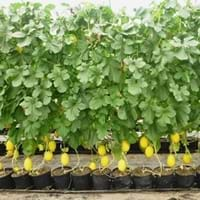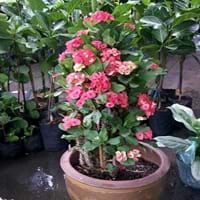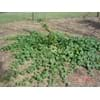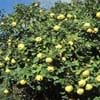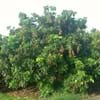Life Span
Annual
Perennial
Origin
Hybrid origin, Africa
Madagascar
Types
Fonzy melon
Not Available
Habitat
Mediterranean region, Subtropical climates, Temperate Regions, Tropical regions
Forests, Rocky areas
USDA Hardiness Zone
Not Available
10-15
Sunset Zone
2a, 2b, 3a, 3b, 4, 5, 6, 7, 8, 9, 10, 11, 12, 13, 14, 15, 16, 17, 18, 19, 20, 21, 22, 23, 24
H1, H2, 13, 21, 22, 23, 24
Habit
Vining/Climbing
Oval or Rounded
Flower Color Modifier
Bicolor
Not Available
Fruit Color
White, Yellow, Gold, Tan, Sandy Brown
Non Fruiting Plant
Leaf Color in Spring
Green, Light Green
Green
Leaf Color in Summer
Green, Light Green
Green
Leaf Color in Fall
Green, Light Green
Green
Leaf Color in Winter
Light Green
Green
Plant Season
Summer, Fall
Spring, Summer, Fall, Winter
Sunlight
Full Sun
Full Sun
Growth Rate
Very Fast
Fast
Type of Soil
Loam
Loam, Sand
The pH of Soil
Neutral
Acidic, Neutral
Soil Drainage
Well drained
Well drained
Bloom Time
Indeterminate
Spring, Late Spring, Early Summer, Summer, Late Summer
Tolerances
Drought
Not Available
Where to Plant?
Container, Ground
Ground, Pot
How to Plant?
Seedlings, Transplanting
stem tip cuttings
Plant Maintenance
Medium
Medium
Watering Requirements
Water Deeply, when new, water every week
Average Water Needs
In Summer
Lots of watering
Lots of watering
In Spring
Moderate
Moderate
In Winter
Average Water
Average Water
Soil pH
Neutral
Acidic, Neutral
Soil Type
Loam
Loam, Sand
Soil Drainage Capacity
Well drained
Well drained
Sun Exposure
Full Sun
Full Sun
Pruning
Remove damaged leaves, Remove dead branches, Remove dead leaves
Remove damaged leaves, Remove dead branches, Remove dead leaves
Fertilizers
All-Purpose Liquid Fertilizer
Full-strength liquid fertilizer
Pests and Diseases
Red blotch
Red blotch
Plant Tolerance
Drought
Drought
Flower Petal Number
Single
Single
Foliage Texture
Coarse
Medium
Foliage Sheen
Matte
Matte
Attracts
Not Available
Ants, Bees, Not Available
Allergy
Asthma, Eczema, Headache, Itchy eyes, Sore eyes
Eye irritation, Skin irritation, Vomiting
Aesthetic Uses
Not Used For Aesthetic Purpose
Borders
Beauty Benefits
Improve skin condition, Skin Problems
Not Available
Environmental Uses
Air purification
Air purification
Medicinal Uses
Antioxidants, Diabetes, Eye Problems, High blood pressure, Nutrients
Antibacterial, Cancer, Schistosomiasis, Sedative
Part of Plant Used
Fruits
Flowers, Latex
Other Uses
Employed in herbal medicine, Used As Food
Used as Ornamental plant
Used As Indoor Plant
Yes
Yes
Used As Outdoor Plant
Yes
Yes
Garden Design
Edible, Fruit / Fruit Tree, Herb / Vegetable, Vine
Bedding Plant, Container, Edging, Foundation, Houseplant, Mixed Border, Tropical
Botanical Name
CUCUMIS melo 'Amy'
EUPHORBIA milii
Common Name
Canary Melon
Crown of thorns, Christ plant, Christ thorn
In Hindi
कैनरी तरबूज
Crown-of-Thorns
In German
Canary Melon
Dornenkrone
In French
Melon Canaries
Couronne d'épines
In Spanish
Melón Canarias
Corona de espinas
In Greek
Κανάριοι Πεπόνι
Crown - of- Αγκάθια
In Portuguese
Canary Melon
Crown -de- espinhos
In Polish
Canary Melon
Korona cierniowa
In Latin
Canary cucumis
Coronam de spinis
Phylum
Streptophyta
Magnoliophyta
Class
Magnoliopsida
Magnoliopsida
Order
Cucurbitales
Euphorbiales
Family
Cucurbitaceae
Euphorbiaceae
Clade
Not Available
Angiosperms, Eudicots, Rosids
Tribe
Not Available
Euphorbieae
Subfamily
Not Available
Euphorbioideae
Number of Species
Not Available
Not Available
Properties of Canary Melon and Crown-of-Thorns
Wondering what are the properties of Canary Melon and Crown-of-Thorns? We provide you with everything About Canary Melon and Crown-of-Thorns. Canary Melon doesn't have thorns and Crown-of-Thorns doesn't have thorns. Also Canary Melon does not have fragrant flowers. Canary Melon has allergic reactions like Asthma, Eczema, Headache, Itchy eyes and Sore eyes and Crown-of-Thorns has allergic reactions like Asthma, Eczema, Headache, Itchy eyes and Sore eyes. Compare all the properties and characteristics of these two plants. Find out which of these plant can be used as indoor plant. If you are interested to decorate your house and garden, find out aesthetic uses, compare them and select the plant which will beautify your surrounding. Along with beautification, try comparing medicinal and edible uses of Canary Melon and Crown-of-Thorns and you can choose the plant having best and most benefits.
Season and Care of Canary Melon and Crown-of-Thorns
Season and care of Canary Melon and Crown-of-Thorns is important to know. While considering everything about Canary Melon and Crown-of-Thorns Care, growing season is an essential factor. Canary Melon season is Summer and Fall and Crown-of-Thorns season is Summer and Fall. The type of soil for Canary Melon is Loam and for Crown-of-Thorns is Loam, Sand while the PH of soil for Canary Melon is Neutral and for Crown-of-Thorns is Acidic, Neutral.
Canary Melon and Crown-of-Thorns Physical Information
Canary Melon and Crown-of-Thorns physical information is very important for comparison. Canary Melon height is 20.30 cm and width 120.00 cm whereas Crown-of-Thorns height is 300.00 cm and width 45.70 cm. The color specification of Canary Melon and Crown-of-Thorns are as follows:
Canary Melon flower color: Yellow
Canary Melon leaf color: Green and Light Green
Crown-of-Thorns flower color: Red
- Crown-of-Thorns leaf color: Green
Care of Canary Melon and Crown-of-Thorns
Care of Canary Melon and Crown-of-Thorns include pruning, fertilizers, watering etc. Canary Melon pruning is done Remove damaged leaves, Remove dead branches and Remove dead leaves and Crown-of-Thorns pruning is done Remove damaged leaves, Remove dead branches and Remove dead leaves. In summer Canary Melon needs Lots of watering and in winter, it needs Average Water. Whereas, in summer Crown-of-Thorns needs Lots of watering and in winter, it needs Average Water.
